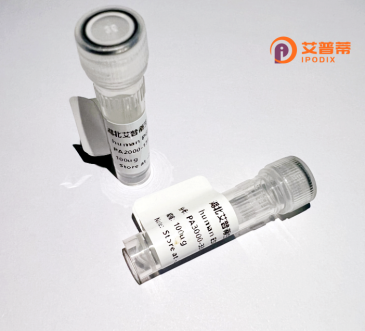
| 纯度 | >90%SDS-PAGE. |
| 种属 | Human |
| 靶点 | EIF5A |
| Uniprot No | P63241 |
| 内毒素 | < 0.01EU/μg |
| 表达宿主 | E.coli |
| 表达区间 | 1-154aa |
| 氨基酸序列 | MADDLDFETGDAGASATFPMQCSALRKNGFVVLKGRPCKIVEMSTSKTGKHGHAKVHLVGIDIFTGKKYEDICPSTHNMDVPNIKRNDFQLIGIQDGYLSLLQDSGEVREDLRLPEGDLGKEIEQKYDCGEEILITVLSAMTEEAAVAIKAMAK |
| 分子量 | 43.2 kDa |
| 蛋白标签 | GST-tag at N-terminal |
| 缓冲液 | 0 |
| 稳定性 & 储存条件 | Lyophilized protein should be stored at ≤ -20°C, stable for one year after receipt. Reconstituted protein solution can be stored at 2-8°C for 2-7 days. Aliquots of reconstituted samples are stable at ≤ -20°C for 3 months. |
| 复溶 | Always centrifuge tubes before opening.Do not mix by vortex or pipetting. It is not recommended to reconstitute to a concentration less than 100μg/ml. Dissolve the lyophilized protein in distilled water. Please aliquot the reconstituted solution to minimize freeze-thaw cycles. |
以下是关于重组人EIF5A蛋白的3篇代表性文献的简要信息:
---
1. **文献名称**:*"Expression and Functional Characterization of Recombinant Human EIF5A in Escherichia coli"*
**作者**:Park JH, et al.
**摘要**:本研究成功在大肠杆菌中表达并纯化重组人EIF5A蛋白,验证其通过hypusine修饰后的活性,证明其在体外促进核糖体翻译延伸功能。
2. **文献名称**:*"EIF5A2 Regulates Metastasis in Colorectal Cancer via Epithelial-Mesenchymal Transition"*
**作者**:Mandal S, et al.
**摘要**:研究揭示了重组人EIF5A2蛋白通过调控上皮间质转化(EMT)促进结直肠癌转移,靶向抑制EIF5A2可降低癌细胞侵袭能力。
3. **文献名称**:*"Hypusinated EIF5A as a Key Mediator of Mitochondrial Apoptosis"*
**作者**:Bassiti A, et al.
**摘要**:本文证明重组人EIF5A的hypusine修饰在氧化应激下激活线粒体凋亡通路,缺失该修饰的突变体显著抑制细胞死亡,提示其病理调控作用。
---
以上文献涵盖了重组人EIF5A蛋白的表达技术、在癌症中的作用机制及翻译后修饰的功能分析,可为相关研究提供参考。
Recombinant human EIF5A (eukaryotic translation initiation factor 5A) is a conserved, multifunctional protein critical for cellular processes such as translation elongation, cell proliferation, and stress response. Originally mischaracterized as a translation initiation factor, EIF5A is now known to facilitate ribosome movement during the synthesis of proline-rich polypeptides, reducing translational stalling. Its activity depends on a unique post-translational modification called hypusination, where the lysine residue at position 50 is converted to hypusine via two enzymatic steps (deoxyhypusine synthase and deoxyhypusine hydroxylase). This modification is essential for EIF5A's functional maturation and its role in mRNA-protein shuttling.
Dysregulation of EIF5A has been linked to cancer, neurodegenerative disorders, and viral infections due to its involvement in inflammation, apoptosis, and immune modulation. Recombinant EIF5A, typically produced in bacterial (e.g., E. coli) or eukaryotic expression systems, enables researchers to study its structure-function relationships, interactomes, and therapeutic potential. Its recombinant form bypasses challenges in isolating native protein and supports drug screening, mechanistic studies, and exploration of EIF5A-targeted therapies, including inhibitors of hypusination for cancer treatment. Current research also investigates its diagnostic value in diseases like Alzheimer’s and HIV-1 pathogenesis.
×